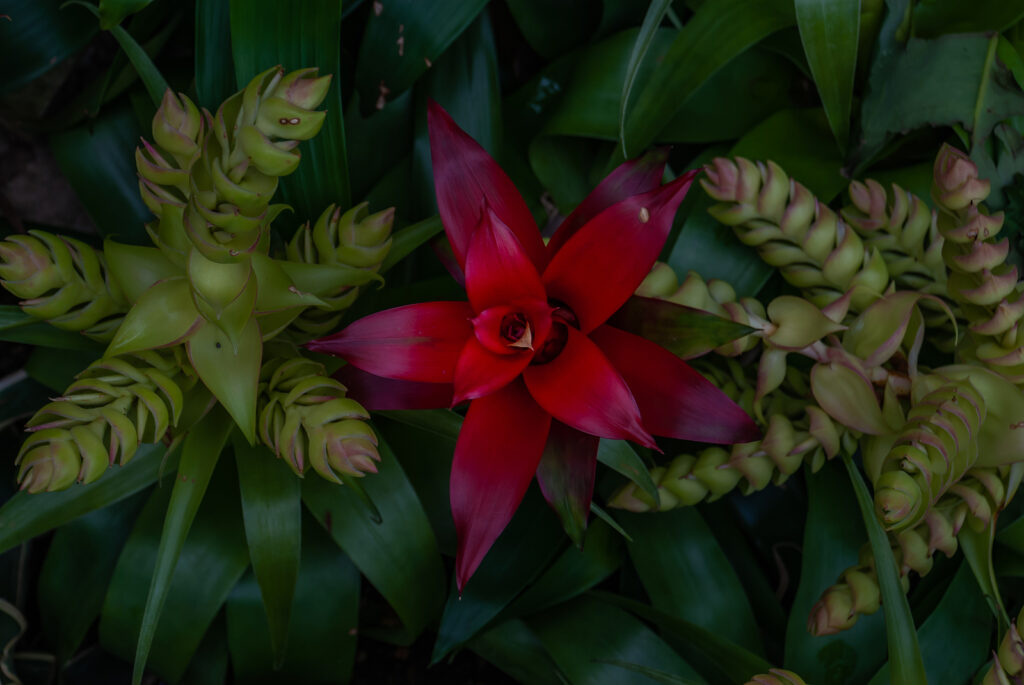Nidularium is a genus of terrestrial or epiphytic bromeliads that produce rosettes of spiny-edged leaves; in the center of the plant, brilliant, red, bract-like leaves form a smaller rosette-like nest–thus the common name bird’s nest plants.
Nidularium has dense, spreading, prickly-margined leaves that form a basal rosette that collects water. When the plant is about to flower, the base of the leaves near the center of the rosette turns color, usually rose-red to dark red.
Flowers are surrounded by colorful bracts that grow in small clusters near the center of the plant. Nidularium may bloom at any time of year.
Nidularium is a genus of 45 species native to rainforests in Brazil.
Get to know Nidularium
- Plant type: Epiphytic and terrestrial bromeliads
- Growing zones and range: Zones 14-15; must be grown indoors when temperatures fall below 54°F (12°C).
- Optimal growing temperature: 55° to 85°F (13° to 29°C)
- Height and width: 8 to 16 inches (20-40cm) tall, 20 to 30 inches (20-75cm) wide
- Foliage: Narrow to broadly strap-shaped toothed leaves
- Flowers: Tubular flowers appears on a short, upright stem; flowers are nestled in a cluster of larger bracts, resembling a bird’s nest
- Bloom time: Any time of the year.
- Uses: Houseplant, tropical garden
- Common name: Bird’s nest plant
- Botanical name: Nidularium
- Family name: Bromeliaceae
- Origin: Brazil

Where to plant Nidularium
- Light indoors: Bright, filtered sun from eastern or western exposure. Will tolerate low light. Air circulation is important.
- Light outdoors: Grow Nidularium in partial shade.
- Soil indoors: Grow Nidularium in pots using epiphytic bromeliad mix.
- Soil outdoors: Grow Nidularium outdoors in a gritty, moderately fertile, leafy soil.
When to plant Nidularium
- Set Nidularium outdoors in a tropical or subtropical garden at any time of the year.
Planting and spacing Nidularium
- Space Nidularium 20 to 30 inches (20-75cm) apart.
How to water and feed Nidularium
- Water: Water Nidularium freely duirng the growing season. Keep the growing medium moist, not soggy. Keep fresh water in plant’s leaf cup. Mist often. Humidity, 45% to 60%.
- Feeding: Feed Nidularium monthly, with mild liquid fertilizer. Avoid oil-based products such as fish emulsion. Spray on leaves, add to water in cup, or apply to growing medium; never feed a dry plant.
Nidularium care
- Nidularium growth slows in winter, reduce water. Keep the medium just moist.
Growing Nidularium as a houseplant
- Nidularium fulgens can be grown as a houseplant.
- Grow Nidularium where the temperature is warm, light is bright and humidity is low.
- Grow plants in a rich, coarse, soilless medium, and keep the medium evenly moist at all times.
- Make sure that there is always water in the cup at the base of the plant.
- Fertilize every month with quarter-strength liquid fertilizer.
Nidularium pests and diseases
- Nidularium is susceptible to scale insect.
Nidularium propagation
- Sow seeds when ripe in very warm soil.
- Separate and replant offsets in spring or summer.
Nidularium varieties to grow
- Nidularium billbergioides.12 inch (30cm) long, pale green leaves, often paler in center and marked with brown spots; bracts are pale pink to yellow, with white flowers.
- N. fulgens, also sold as N. regelioides, blushing bromeliad. Grows 16 inches (40cm) tall and 24 inches (60cm) wide; produces 12-inch long, light green leaves with dark green spots; scarlet bracts encircle white flowers.
- N. innocentii var. innocentii. 12 inch (30cm) long, two-tone leaves with dark red undersides and green tops; flower bracts are red with green tips, flowers are white.
- N. innocentiI var. lineatum has lengthwise white markings on leaves; green bracts have red tips.
- N. procerum. Grows 8 to 12 inches tall and 30 inches wide; waxy, pale green leaves are finely toothed; bears as many as 30 tubular, blue-tipped vermilion flowers among clusters of red bracts.
- N. rutilans. Grows 12 inches tall and 18 inches wide; strap-shaped bright green leaves; bright red bracts surround clusters of tubular red flowers.
- N. scheremetiewii. Blue flowers appear atop short-stalked red bracts; light green leaves with short spines on edges.















